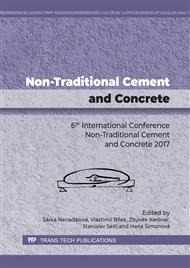p.87
p.92
p.96
p.103
p.111
p.116
p.120
p.127
p.131
Change of a Crack Propagation Rate in Fine-Grained Cement-Based Composites due to Partial Replacement of Aggregate by Ceramic Waste
Abstract:
Concrete used in civil structures is usually made on cement-based matrix and natural aggregates (such as sand, gravel, crushed stone, etc.). Ceramic waste aggregate is considered as a perspective replacement of a part of natural aggregate in modern environmentally oriented building material. Concrete with natural aggregate partially replaced by ceramic waste aggregate usually show different mechanical characteristics than ordinary concrete. This paper introduces the pilot study of fatigue parameters of six concrete mixtures with various amount of ceramic waste. The experimentally obtain results are compared and discussed.
Info:
Periodical:
Pages:
111-115
Citation:
Online since:
January 2018
Authors:
Price:
Сopyright:
© 2018 Trans Tech Publications Ltd. All Rights Reserved
Share:
Citation:


